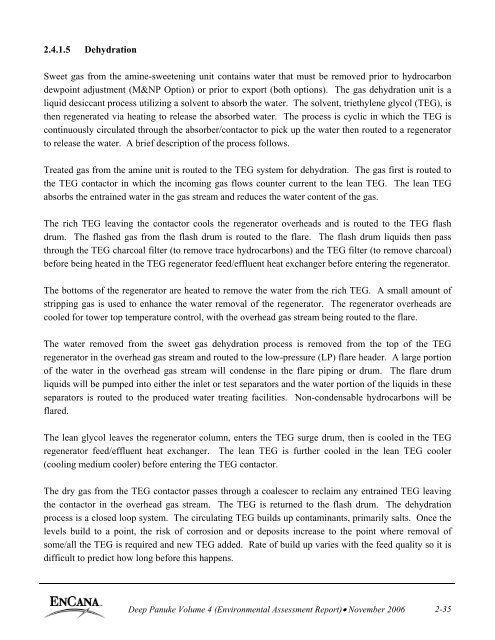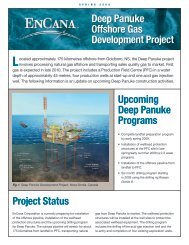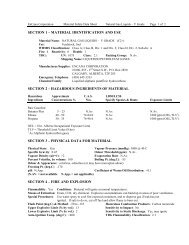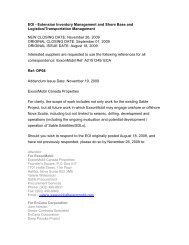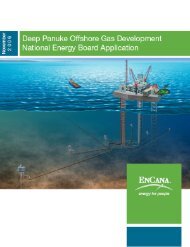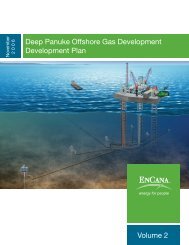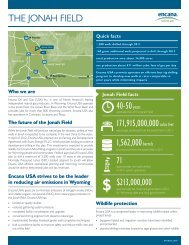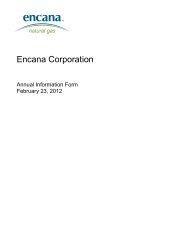Deep Panuke Project Description - Encana
Deep Panuke Project Description - Encana
Deep Panuke Project Description - Encana
Create successful ePaper yourself
Turn your PDF publications into a flip-book with our unique Google optimized e-Paper software.
2.4.1.5 DehydrationSweet gas from the amine-sweetening unit contains water that must be removed prior to hydrocarbondewpoint adjustment (M&NP Option) or prior to export (both options). The gas dehydration unit is aliquid desiccant process utilizing a solvent to absorb the water. The solvent, triethylene glycol (TEG), isthen regenerated via heating to release the absorbed water. The process is cyclic in which the TEG iscontinuously circulated through the absorber/contactor to pick up the water then routed to a regeneratorto release the water. A brief description of the process follows.Treated gas from the amine unit is routed to the TEG system for dehydration. The gas first is routed tothe TEG contactor in which the incoming gas flows counter current to the lean TEG. The lean TEGabsorbs the entrained water in the gas stream and reduces the water content of the gas.The rich TEG leaving the contactor cools the regenerator overheads and is routed to the TEG flashdrum. The flashed gas from the flash drum is routed to the flare. The flash drum liquids then passthrough the TEG charcoal filter (to remove trace hydrocarbons) and the TEG filter (to remove charcoal)before being heated in the TEG regenerator feed/effluent heat exchanger before entering the regenerator.The bottoms of the regenerator are heated to remove the water from the rich TEG. A small amount ofstripping gas is used to enhance the water removal of the regenerator. The regenerator overheads arecooled for tower top temperature control, with the overhead gas stream being routed to the flare.The water removed from the sweet gas dehydration process is removed from the top of the TEGregenerator in the overhead gas stream and routed to the low-pressure (LP) flare header. A large portionof the water in the overhead gas stream will condense in the flare piping or drum. The flare drumliquids will be pumped into either the inlet or test separators and the water portion of the liquids in theseseparators is routed to the produced water treating facilities. Non-condensable hydrocarbons will beflared.The lean glycol leaves the regenerator column, enters the TEG surge drum, then is cooled in the TEGregenerator feed/effluent heat exchanger. The lean TEG is further cooled in the lean TEG cooler(cooling medium cooler) before entering the TEG contactor.The dry gas from the TEG contactor passes through a coalescer to reclaim any entrained TEG leavingthe contactor in the overhead gas stream. The TEG is returned to the flash drum. The dehydrationprocess is a closed loop system. The circulating TEG builds up contaminants, primarily salts. Once thelevels build to a point, the risk of corrosion and or deposits increase to the point where removal ofsome/all the TEG is required and new TEG added. Rate of build up varies with the feed quality so it isdifficult to predict how long before this happens.<strong>Deep</strong> <strong>Panuke</strong> Volume 4 (Environmental Assessment Report)• November 2006 2-35


